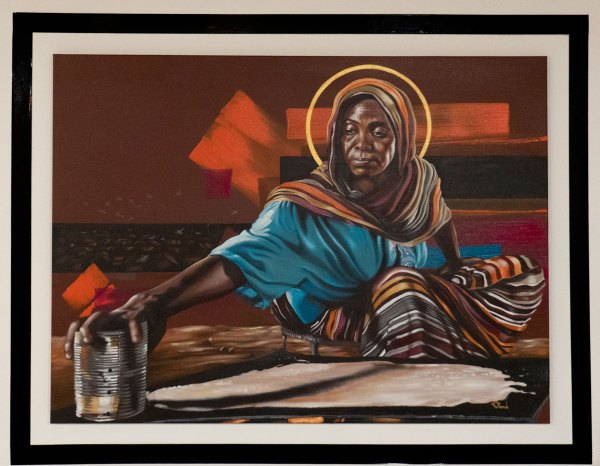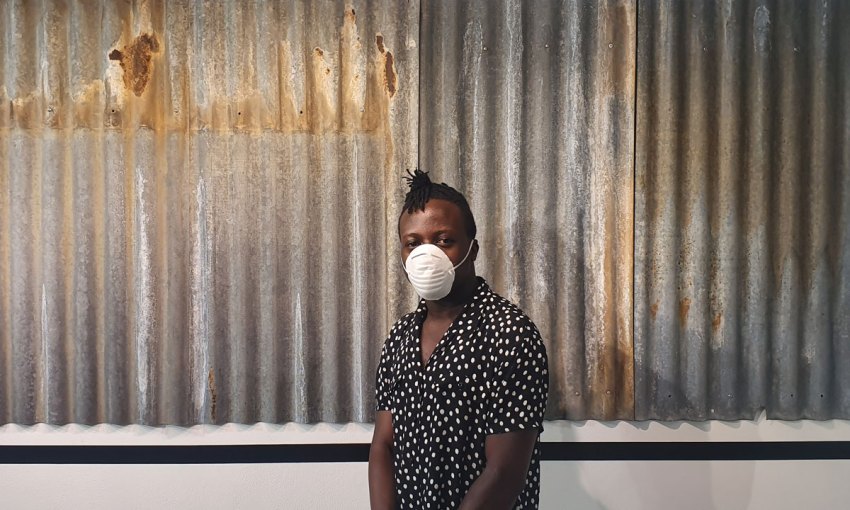In light of you know what, Nexus Arts will present its latest exhibition online – with virtual visitors given the opportunity to ‘graffiti’ a corrugated iron artwork by Ugandan artist Wamala Kyeyune Joseph.
Nexus goes digital with ‘I Am Because You Are’
SPECIAL REPORT: COVID-19 ADELAIDE
I AM BECAUSE YOU ARE – Illustrations of Existence is the result of a collaboration between Nexus and the SANAA Festival, with Wamala Kyeyune Joseph (The.Wamala) one of six artists from across Africa who visited Adelaide in February to take part in the festival’s 14-day program.
During a seven-week artist exchange residency, he created new work in Nexus’s studio space alongside South Australian mixed-media artist Tailor Winston.
I AM BECAUSE YOU ARE – Illustrations of Existence opens at Nexus Arts on May 14 and can be viewed here.
“Wamala was here during the Fringe and Festival period, so it was a really vibrant time for him to engage with Adelaide,” Nexus Arts artistic director Emily Tulloch says.
“He was really keen to meet with creatives here and learn more about Australia and its culture, and that’s why we decided to make the exhibition a joint one.”
Wamala and Tailor shared their experiences and produced work together, with Tailor making plaster casts of Wamala’s hands to contribute to one of her creations.
But then, just as the gallery was beginning to install the exhibition, the COVID-19 pandemic shutdown started. Nexus closed its gallery, venue and offices on 17 March, and three days later Wamala flew home.
“He arrived 10 hours before the country closed its borders… it was a very hurried goodbye,” Emily says.
Luckily, 18 works had been completed for I AM BECAUSE YOU ARE – Illustrations of Existence, all based around the theme ‘the human condition.’
Although the physical exhibition has been installed in the Nexus gallery, the Nexus team has adapted it for a digital platform that launches this Thursday, 14 May.
Viewers can take themselves on an online tour, with behind-the-scenes footage of the exhibition installation, high-resolution photos and video portraits of the artworks, and a virtual video tour of the display.

‘The Guardian’, by Wamala Kyeyune Joseph. Photo: Aaron Schuppan
The coronavirus pandemic has made some of the artists’ themes more relevant than ever, with Tailor exploring ideas of resilience and interconnectedness while Wamala is interested in “the beauty to be found within the struggle”.
The centrepiece is Wamala’s corrugated iron work Mabati (pictured at the top of this article). It was originally intended that visitors to the exhibition would be provided with paint so they could add their own graffiti to it, but now they will be able to use the online artwork portal to create digital “graffiti” in the form of their own messages. Given current events, the gallery expects the messages will convey a mixture of emotions ranging from hope to distress and anger.
“Corrugated iron sheets, called ‘mabati’ in the Ugandan local language Luganda, are generally used as roofing and shelter and are represented in all my artworks in this exhibition, symbolising barriers that surround life’s journey to self-actualisation,” Wamala explains.
“I use iron sheets to illustrate how people hide what they are physically constructing by fencing themselves behind mabati, while on the outside people turn these iron fences into walls of expression through writing, spraying, drawing and advertising.”
Wamala’s other works are vibrant portraits of African women, born of his respect for their resilience and for the sacrifices they make for their families and communities.
Multi-disciplinary artist Tailor – who has Australian, African-American and Italian heritage – explores the nature of the human condition in relationship to the natural world through her exhibition works, which are mostly sculptural and incorporate natural objects.

Tailor Winston’s ‘Aviary’.
Emily Tulloch says new content to be added to the digital exhibition in coming weeks will include a performance by the local artist.
“It involves her shaving her hair on camera then using a hand loom to weave it into thread that then connects into one of the sculptures.”
The artistic director says her role in leading Nexus is to support artists and arts creation; to offer a “hub of connectedness, understanding, and intercultural sharing, and a space to share, explore, and develop” – all of which leads to the next step of sharing artists’ work with audiences and fostering a circular relationship between the two.
The current pandemic has highlighted the importance of relationships and connectedness, with the exhibition also bringing them to the fore for the team at Nexus.
And while online experiences can’t replace the communal aspect of shared, live, real-world experiences, Emily says the digital exhibition has enabled Nexus to explore a new way of connecting with people and making artists’ work accessible to a broader audience.
“It’s been a bit of a wild ride and it’s certainly been an interruption, but there are some positive things that have come out of it and one of those is that Wamala’s friends and family back in Uganda will be able to view the exhibition the same way our community here can.”




